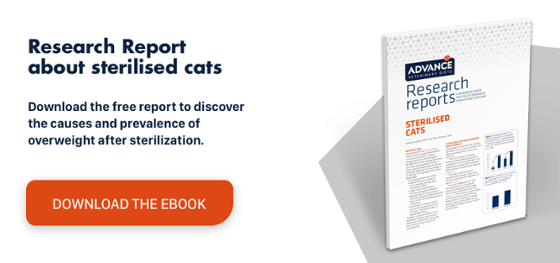Feed for cats. A high-quality diet for sterilised cats
Importance of weight gain
The sterilisation of cats is a routine surgical procedure in small animal clinics, while its advantages make it an important practice for pet health in general. On the other hand, the hormonal changes in sterilised patients come with organic changes that must be treated.
After sterilisation, the animal’s increased appetite, meaning a larger food intake, coupled with a decrease in basal metabolism, leads to significant weight gain.
The accumulation of adipose tissue causes direct pathophysiological changes in the cat’s body, translating into extra strain on various systems, most notably the musculoskeletal system1.
Furthermore, obese patients tend to present a greater risk of developing diabetes, a disease characterised by the animal’s partial or total inability to produce insulin, giving rise to clinical signs ranging from polyuria, polyphagia and polydipsia to pancreatitis, kidney failure or heart failure.
To ensure animal wellbeing, veterinary professionals have the important duty of increasing owners’ awareness of the potential risks for pets with a high body condition score.
Managing obese cats after sterilisation
Before making any changes to the cat’s routine, calculate the patient’s optimal weight, then use this to establish short-term goals and guidelines for achieving them.
Two points are crucial to controlling an animal’s weight and body condition:
- Exercise: it is important to increase the cat’s physical activity, using toys and other techniques, to reduce its adipose tissue and maintain a healthy musculoskeletal system.
- Dietary control: the choice of diet and amount of food must be considered together, as these are essential factors in the postoperative management of sterilised cats.
They cannot be dealt with separately because treatment success depends on how they are combined and then adapted and maintained over time.
Feed: diets available on the market
The dietary goals for sterilised cats are to reduce body weight and maintain a healthy condition.
We must clarify that reducing the daily ration of food is not an appropriate approach; simply reducing the amount of food also means a decrease in the daily intake of nutrients which the animal requires. Which is why the patient’s daily intake of food must be assessed previously to avoid an excessive or deficient intake of any nutrients.
Special commercial diets for sterilised cats typically include high-quality protein, a reduced fat content, added amino acids, such as L-carnitine, to improve fat metabolism, and satiating substances so it is not rejected.
An example of these diets is the ADVANCE STERILIZED range, which contains all the ingredients listed above to ensure cats maintain an ideal body weight without neglecting any essential nutrients and is of an optimal pH to reduce the risk of urinary problems. ADVANCE has launched a new diet for patients with recurrent urinary stones to help control weight while maintaining a healthy urinary tract (ADVANCE Urinary).

